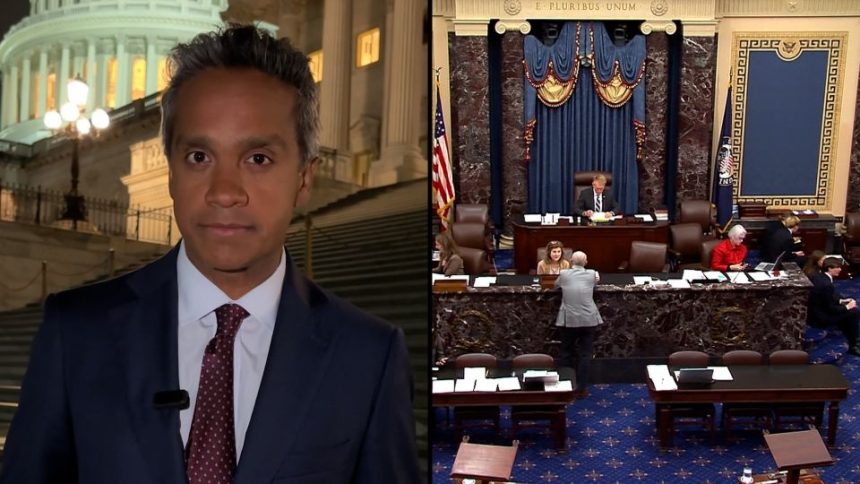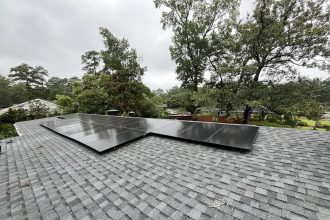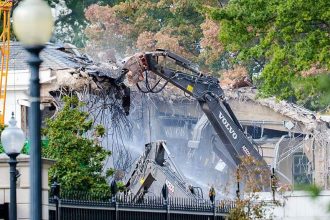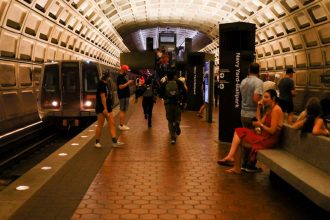Senators have approved a funding package to reopen the federal government, sending the compromise deal to their colleagues in the House.
Centrist Senate Democrats struck a deal over the weekend with Republicans to move forward the package, without securing their party’s demand to guarantee an extension of enhanced Affordable Care Act subsidies, which help millions of Americans afford health insurance. Ultimately, eight members of the Democratic caucus crossed lines to move a step closer to breaking the stalemate on Capitol Hill.
Now, the focus is on the House, where GOP leaders believe lawmakers will end the stalemate this week.
Here’s what still needs to happen on Capitol Hill to reopen the federal government.
It’s the House’s turn
The Senate-passed package would fund the government until January 30 and some key agencies through t he remainder of fiscal year 2026. So that means if the government were to shut down again over the next few months, key federal food assistance known as SNAP would continue to be funded.
House Speaker Mike Johnson has to sell this package to his razor-thin GOP majority, and he’ll likely need the president’s help.
Johnson told his members Monday to start making their way back to Washington and put them on 36-hour vote notice after the Senate passed the continuing resolution, or CR, to fund the government.
“I’m stating the obvious: All my colleagues, Republicans and Democrats in the House, you need to begin right now, returning to the Hill. We have to do this as quickly as possible,” the Republican leader said Monday.
When will the House vote?
The House plans to begin voting on the Senate-passed bill to reopen the federal government on Wednesday, according to a notice from Majority Whip Tom Emmer.
The vote will take place as early as 4 p.m., per the notice, which forecasts multiple votes that day.
On Tuesday, the House Rules Committee is expected to consider the Senate package to set up floor activity on Wednesday.
The House hasn’t voted or been in legislative session since September 19.
Who are the lawmakers to watch?
Johnson will have to work closely with the White House to muscle this deal through the House, given it is unclear how many Democrats will cross over to support the package and Republicans hold such a narrow majority.
Fourteen moderate House Republicans had wanted to see the expiring enhanced Affordable Care Act subsidies extended and had their own bill to address the issue at the center of the shutdown fight.
Meanwhile, House Democratic leadership is actively working to prevent rank-and-file members from voting for this bill because they say it falls short of what Democrats fought for during the shutdown. Democratic Rep. Jared Golden, who is not seeking reelection and has been known to vote with Republicans, is among those to watch.
What are House Democratic leaders saying?
House Minority Leader Hakeem Jeffries has vowed to fight the package because it does not go as far as he wanted on Democrats’ health care demands.
Jeffries and his team hope to limit the number of Democrats who support the plan, which will maximize pressure on House Republicans to land the votes themselves. And House Democratic leaders are officially whipping against the Senate funding compromise, according to two sources familiar with the plans.
The House Democratic leader reiterated to CNN’s Wolf Blitzer on Tuesday that Democrats will “strongly oppose any legislation that does not decisively address the Republican health care crisis.”
“We want to reopen the government. We’ll continue to stand by our hardworking federal employees and civil servants. But we have a responsibility to make sure that we extend the Affordable Care Act tax credits so that tens of millions of Americans don’t experience dramatically increased health care costs that’s going to prevent them from being able to see a doctor when they need one,” Jeffries said on “The Situation Room.”
Does the government open as soon as the House passes the bill?
Not quite yet.
Once passed in the House, the bill will go to President Donald Trump’s desk for his signature.
What does Trump think of the bill?
The White House has already endorsed the Senate plan to reopen the government, calling the funding deal a “positive development” toward ending the record-long shutdown.
“President Trump has wanted the government reopened since the first day Democrats shut it down,” a White House official said in a statement. “The action in the Senate is a positive development and we look forward to seeing it progress.”
And adding to expectation that Trump will sign the measure, the president told CNN’s Kaitlan Collins, “I would say so,” when asked whether he personally approved of the deal making its way through Capitol Hill.
“I think, based on everything I’m hearing, they haven’t changed anything, and we have support from enough Democrats, and we’re going to be opening up our country,” Trump said Monday. “It’s too bad it was closed, but we’ll be opening up our country very quickly.”
What’s in the funding package?
The full bill includes a larger funding package negotiated between the two parties and a stopgap measure through January 30.
The broader legislative package would include three full-year appropriations bills that deal with military construction and veterans affairs, the legislative branch and the Department of Agriculture.
That includes $203.5 million in new funding to enhance security measures and protection for members of Congress, in addition to $852 million for US Capitol Police, per a summary of the bill to fund the legislative branch provided by top Democratic appropriator Sen. Patty Murray.
The package does not include a guarantee from Republicans to extend the expiring enhanced Affordable Care Act subsidies that have been at the heart of the funding fight.
As part of the deal struck between Republicans and the Senate Democratic centrists, there’s expected to be a future Senate vote on the subsidies.
Behind the scenes, Senate Democrats who backed the deal to reopen the government said Trump’s increasing opposition in recent days to extending expiring enhanced Obamacare subsidies – a key sticking point for the Democratic Party – forced them to change their position and accept a compromise to end an indefinite government shutdown, according to sources familiar with their thinking.
The deal also includes an agreement to reverse the federal firings during the shutdown and ensure that all federal workers get paid what they were owed during the shutdown.
This headline and story have been updated with additional developments.
For more CNN news and newsletters create an account at CNN.com









